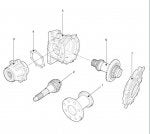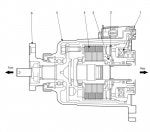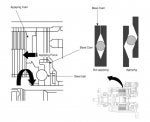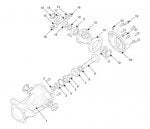I'm going to start with a link to a website that explains all the different AWD systems. Then I'm going to post pictures from the parts manual and Kiatechinfo, which will show the transfer of power.
All Wheel Drive Explained | awd, 4x4, 4wd, 4motion, quattro, xDrive, SH-AWD, Haldex, Torsen, wiki - How it works
The 2011 Sorento uses the automatic all wheel drive version.
First, the components: There is a front output. It is a ring and pinion similar to those in a differential, without the spider gears to allow for differential speeds of the output shafts. It's purpose is purely to change the direction of the power from the transverse of the engine to longitudinal; from sideways to front and back. Important to note is that the output is directly coupled to the transmission, if it's spinning the output of this is spinning.
Next is the driveshaft, or as Kia calls it, a Propeller Shaft. Standard simple driveshaft that goes from front output to rear coupler. This is a two-piece shaft with a ujoint between the front output and the front shaft, then a middle carrier, and the rear shaft is directly bolted to the coupler assembly.
Next is the coupler assembly, which is the mechanical key to the system. It is a clutch system which, when power is applied, pushes against the clutch pack with a dual-ramp system to connect the input and output. Of note is that unless voltage is applied to the actuator, the clutch pack is open and no power is transmitted.
Finally is the rear differential assembly. This is a standard differential, one input, two outputs at 90* to the input. There is no limited slip, just an open carrier with two spider gears on one cross-shaft.
Ok, theory of operation. In normal operation, the vehicle is front wheel drive, 100%. The driveshaft/propeller shaft spins whenever the vehicle is in motion, as parasitic loss. The rear wheels are turned by the road, which spin the rear differential. It's this way because the system cannot take torque away from the front, it can only send 'waste' torque to the rear. Waste torque is identified by the AWD/TCS/VSCS (All Wheel Drive/Traction Control System/Vehicle Stability Control System) noting a condition such as front wheel speed higher than the rear, or a lateral slip of the vehicle caused by wheel slippage.
Once the need for all wheel drive is identified, the computer sends voltage into the actuator which squeezes the clutch pack, completing the transfer of power from the engine to the rear wheels. Once the wheelspeed is what the computer decides is correct, or the vehicle instability condition is passed, it removes voltage and the vehicle goes back to front wheel drive. Of note is that there is no center diff. The vehicle is not designed to be full time AWD. This is why if you press the 4wd button, which applies voltage to the actuator, the vehicle will hop and jump around corners. There must be some differentiation of wheelspeed between the front and rear wheels when you go around a corner. If there is no differential to even out the speeds, the difference must be taken up in wheel slip.
The disadvantages of this system are that you take a gas mileage hit; there is a fair amount of parasitic drag. Also, it is not a fulltime AWD system, so is not theoretically as responsive. Unlike some vehicles with a true transfer case, you cannot in an emergency pull one or the other driveshaft and operate as a 2wd vehicle (in some 4x4s if you lose a rear driveshaft, you can put it in 4wd part-time and drive in front wheel drive, etc.)
The advantages are lighter weight than a fulltime all wheel drive system, since there is no center differential. The system is simpler mechanically, but more complex electrically. It is much easier to graft onto a front wheel drive vehicle than a fulltime system. Since it's connected by a clutch pack, it cannot transfer 100% of the engine's torque; I tried and failed to back mine up onto a pair of ramps in 4wd mode because the clutch pack kept slipping. Finally, it's failsafe; if the system fails, you still have a front wheel drive vehicle.
The system is similar to one used in my son's Volvo S40, although he pointed out that the Kia system reacts much more quickly than his; he can get some wheelspin in the front before it engages the rear. On mine, as soon as slip is noticeable (flooring it from a dead stop in my gravel drive) it engages the rear and the vehicle accelerates.
If requested, later posts will compare and contrast this system to others, as this is somewhat of a hobby of mine.
Edit: Of interest to other tech-heads, Kiatechinfo now has the info up for the 2012 models, including the GDI engine.
All Wheel Drive Explained | awd, 4x4, 4wd, 4motion, quattro, xDrive, SH-AWD, Haldex, Torsen, wiki - How it works
The 2011 Sorento uses the automatic all wheel drive version.
First, the components: There is a front output. It is a ring and pinion similar to those in a differential, without the spider gears to allow for differential speeds of the output shafts. It's purpose is purely to change the direction of the power from the transverse of the engine to longitudinal; from sideways to front and back. Important to note is that the output is directly coupled to the transmission, if it's spinning the output of this is spinning.
Next is the driveshaft, or as Kia calls it, a Propeller Shaft. Standard simple driveshaft that goes from front output to rear coupler. This is a two-piece shaft with a ujoint between the front output and the front shaft, then a middle carrier, and the rear shaft is directly bolted to the coupler assembly.
Next is the coupler assembly, which is the mechanical key to the system. It is a clutch system which, when power is applied, pushes against the clutch pack with a dual-ramp system to connect the input and output. Of note is that unless voltage is applied to the actuator, the clutch pack is open and no power is transmitted.
Finally is the rear differential assembly. This is a standard differential, one input, two outputs at 90* to the input. There is no limited slip, just an open carrier with two spider gears on one cross-shaft.
Ok, theory of operation. In normal operation, the vehicle is front wheel drive, 100%. The driveshaft/propeller shaft spins whenever the vehicle is in motion, as parasitic loss. The rear wheels are turned by the road, which spin the rear differential. It's this way because the system cannot take torque away from the front, it can only send 'waste' torque to the rear. Waste torque is identified by the AWD/TCS/VSCS (All Wheel Drive/Traction Control System/Vehicle Stability Control System) noting a condition such as front wheel speed higher than the rear, or a lateral slip of the vehicle caused by wheel slippage.
Once the need for all wheel drive is identified, the computer sends voltage into the actuator which squeezes the clutch pack, completing the transfer of power from the engine to the rear wheels. Once the wheelspeed is what the computer decides is correct, or the vehicle instability condition is passed, it removes voltage and the vehicle goes back to front wheel drive. Of note is that there is no center diff. The vehicle is not designed to be full time AWD. This is why if you press the 4wd button, which applies voltage to the actuator, the vehicle will hop and jump around corners. There must be some differentiation of wheelspeed between the front and rear wheels when you go around a corner. If there is no differential to even out the speeds, the difference must be taken up in wheel slip.
The disadvantages of this system are that you take a gas mileage hit; there is a fair amount of parasitic drag. Also, it is not a fulltime AWD system, so is not theoretically as responsive. Unlike some vehicles with a true transfer case, you cannot in an emergency pull one or the other driveshaft and operate as a 2wd vehicle (in some 4x4s if you lose a rear driveshaft, you can put it in 4wd part-time and drive in front wheel drive, etc.)
The advantages are lighter weight than a fulltime all wheel drive system, since there is no center differential. The system is simpler mechanically, but more complex electrically. It is much easier to graft onto a front wheel drive vehicle than a fulltime system. Since it's connected by a clutch pack, it cannot transfer 100% of the engine's torque; I tried and failed to back mine up onto a pair of ramps in 4wd mode because the clutch pack kept slipping. Finally, it's failsafe; if the system fails, you still have a front wheel drive vehicle.
The system is similar to one used in my son's Volvo S40, although he pointed out that the Kia system reacts much more quickly than his; he can get some wheelspin in the front before it engages the rear. On mine, as soon as slip is noticeable (flooring it from a dead stop in my gravel drive) it engages the rear and the vehicle accelerates.
If requested, later posts will compare and contrast this system to others, as this is somewhat of a hobby of mine.
Edit: Of interest to other tech-heads, Kiatechinfo now has the info up for the 2012 models, including the GDI engine.









